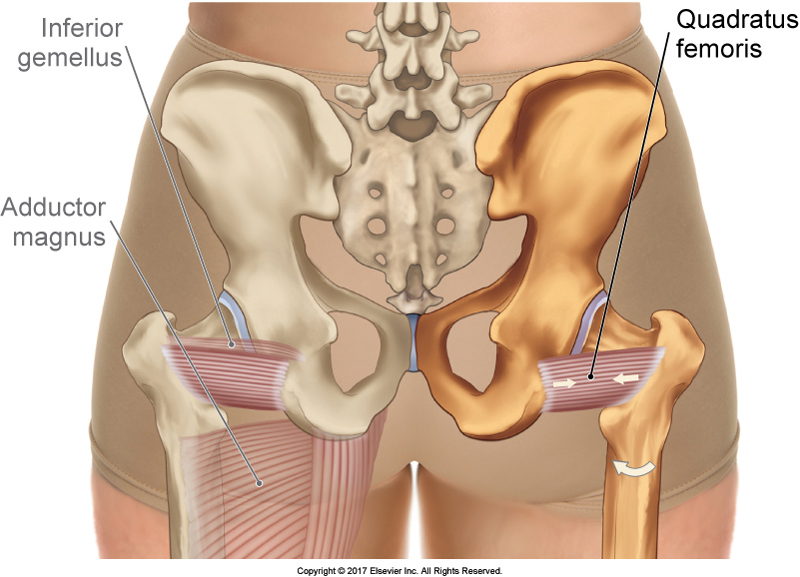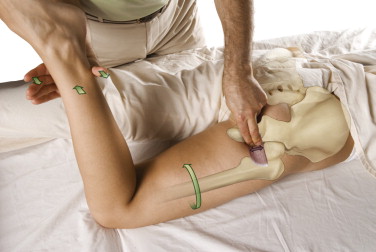Attachments and Actions of the Quadratus Femoris
The quadratus femoris is a muscle of the gluteal/hip joint region. It attaches from the lateral border of the ischial tuberosity to the intertrochanteric crest of the femur, between the greater and less trochanters (Figure 8). The quadratus femoris crosses the hip joint posteriorly with a horizontal direction to its fibers; therefore it laterally (externally) rotates the thigh at the hip joint. Indeed, along with the piriformis it is one of the six members of the deep lateral rotator group.

Figure 8. Posterior view of the quadratus femoris. Courtesy of Joseph E. Muscolino. The Muscular System Manual – The Skeletal Muscles of the Human Body, 4ed. Elsevier 2017.
Palpation Assessment of the Quadratus Femoris
Although the quadratus femoris is deep to the gluteus maximus, it is usually easily palpated and discerned from adjacent musculature. To palpate the quadratus femoris, first find the inferior aspect of the ischial tuberosity. Follow the ischial tuberosity to its lateral border by maintaining pressure against the bone as you move laterally along it. Once the lateral border has been reached, drop immediately lateral to it and you will be on the quadratus femoris. To engage the muscle to confirm that you are on it, have the client try to laterally rotate the thigh at the hip joint against your gentle to moderate resistance. This is accomplished by asking the client to try to push the (lower) leg medially against the resistance of your hand (Figure 9). Palpate the entirety of the muscle as the client gently contracts and relaxes it. Once located, moderate to deeper pressure can be applied to work the muscle. Note: The sciatic nerve usually passes superficial to the quadratus femoris immediately lateral to the ischial tuberosity. If the sciatic nerve is contacted, move fingers pads slightly lateral to avoid pressure on the nerve.

Figure 9. Palpation of the right quadratus femoris. Courtesy of Joseph E. Muscolino. The Muscle and Bone Manual, with Trigger Points, Referral Patterns, and Stretching, 2ed. Elsevier 2016.
Stretching the Quadratus Femoris
The quadratus femoris laterally (externally) rotates the thigh at the hip joint; therefore it can be stretched with medial (internal) rotation. It is also a horizontal abductor, so it can be stretched with horizontal adduction (Figure 10).

Figure 10. Stretching the right quadratus femoris, therapist-assisted (A) and self-care (B). Courtesy of Joseph E. Muscolino. The Muscle and Bone Manual, with Trigger Points, Referral Patterns, and Stretching, 2ed. Elsevier 2016.
Case Study – Quadratus Femoris
Belinda presented with pain in her right gluteal region that had begun the day before. She stated that she had been stretching her hip joint fairly vigorously when she first felt a sharp pain occur in the area. Concerned that she might have injured herself, she decided to seek care immediately and presented to my office the day after the pain began. Upon palpation examination, I went for the usual suspect, the piriformis; but her piriformis was healthy and palpation of it did not reproduce any pain or discomfort. However, as I continued to palpate inferior and lateral to the piriformis, I came upon a trigger point in the quadratus femoris, that when pressed, reproduced Belinda’s characteristic pain pattern. Because Belinda came in so quickly after the onset of the problem, one session of moist heat, deep stroking massage, and stretching was sufficient to entirely resolve the trigger point and eliminate all of her pain and discomfort.
Note: This blog post article is the fourth in a series of 8 posts on
Unusual Suspect Muscles of the Body*
The 8 Blog Posts in this Series are:
- Introduction
- Palmar Interossei (PI)
- Flexor Pollicis Longus (FPL)
- Quadratus Femoris (QF)
- Coccygeus & Levator Ani
- Sternohyoid
- Longus Colli & Longus Capitis
- Other Unusual Suspects…
* This series of blog post articles is modified from an article originally published in massage and bodywork (m&b) magazine: The Unusual Suspects. November/December 2016 issue.


